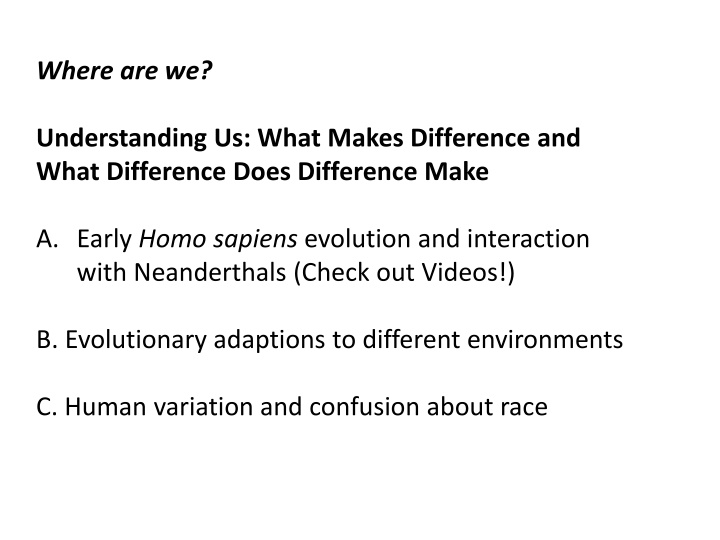
Human Evolution and Variability: Understanding Our Differences
Explore the evolution of early Homo sapiens, their interactions with Neanderthals, and adaptations to different environments. Delve into human variation, skin pigmentation, lactase persistence, and more. Questioning misconceptions about race and discussing recent findings in human evolution, including the detection of genetic selection and the influence of traits like skin color and earwax. Reflect on the complexity of genetic factors in athleticism and the historical context of portrayals of Black and White athletes in sports literature.
Download Presentation

Please find below an Image/Link to download the presentation.
The content on the website is provided AS IS for your information and personal use only. It may not be sold, licensed, or shared on other websites without obtaining consent from the author. If you encounter any issues during the download, it is possible that the publisher has removed the file from their server.
You are allowed to download the files provided on this website for personal or commercial use, subject to the condition that they are used lawfully. All files are the property of their respective owners.
The content on the website is provided AS IS for your information and personal use only. It may not be sold, licensed, or shared on other websites without obtaining consent from the author.
E N D
Presentation Transcript
Where are we? Understanding Us: What Makes Difference and What Difference Does Difference Make A. Early Homo sapiens evolution and interaction with Neanderthals (Check out Videos!) B. Evolutionary adaptions to different environments C. Human variation and confusion about race
B. Evolutionary adaptions to different environments Ex. Lactase Persistence (We covered this) Ex. Skin Pigmentation Ex. Sickle Cell (CH 6 and in Part 4 White Matter) Lots more Examples from Reading on Recent Human Evol C. Human variation and confusion about race Part 1 Skin in the Game Part 2 Your Ancestors are my Ancestors Part 3 Black Power (Today) Health and Race (Friday)
Questions to think about as you read. 1. Why do you think we used to imagine that humans would not experience natural selection? 2. Pick out and describe all the examples of recent evolution in humans (what is up with earwax-was it selected for?). 3. How did they detect the occurrence of selection? 4. If a trait was selected for a very long time ago, how would the regions around that gene differ from whether it was more recently selected for? 5. They point out that there are at least 25 genes that play a role in skin pigmentation. How accurate do you think this number is? 6. Describe the skin color example. 7. The authors note that ear wax differs between populations, but are not sure what survival advantage different kinds of earwax might confer. Instead they think the difference exists due to ..? 8. Africans show the highest levels of neutral or background variation while Europeans and East Asians seem to show more genes under recent selection. Why might both these patterns exist? 9. Hard vs. soft sweeps? What does this mean?
Part 3 Black Power About the confusion regarding the relationship between skin color and athletic ability. Tells the story of the pursuit of genes that influence athleticism. The search for particular genes that influence complex traits has always and continues to be a focus of research. This is a representative cautionary tale! Random interesting fact: Olympic rings originally represented the 5 continents Africa-black, Asia-yellow, America-red, Australasia-green, Europe-blue
When we analyze sports literature we find. innate physical ability was typical in descriptions of Black athletes and intellectual prowess or industriousness was the most frequently referenced criterion for success in Whites. p148 Looks closely at the Olympics and compares Sprinters vs Long Distance Runners Many think one or both of these things might be true Those with West African heritage are genetically predisposed to be good sprinters because ..(?) Those descended from enslaved peoples are good sprinters since that trait might have been selected for. Maybe this is kind of reasonable right?
What is the evidence for superior Sprinting performance in Blacks from this part of Africa? When was the last time a white person won the 100 meter in Olympics? (1980) .which was also the last time a white man competed in the final. There are a lot of Black sprinters! Athletes themselves use ancestry as a reason for their success. Michael Johnson (sprinter) had ancestry test- West Africa. all my life I thought it was through my determination but it is impossible to think that being descended from slaves hasn t left an imprint.. p130
But really, how well does the slave hypothesis for sprinting hold up? Questionable because Many slaves were doing diverse and highly skilled tasks Actually lots of interbreeding with Europeans! Effect should be small because selection did not happen for very long And actually there are no signs of selection in any part of the genome p131 Slaves were introduced into South America-where are those descendants? Why aren t they excellent sprinters? So really no evidence that slavery caused this association!
Other questions you have to ask yourself. If African Americans have genetic advantages that imbue them with greater sprinting power, why do they not also dominate other sports? (sprint cycling, swimming, tennis, wrestling) Why do they do well in boxing but not wrestling? People used to say this about Finnish runners in their blood-they are like animals in the forest. It is unlikely that Africa is producing unique genotypes that cannot be found in other parts of the world.
Are there genes that might make Blacks good sprinters (power) or long distance runners (stamina)? What do we know and how do we do this research? Look for elite athletes and look for gene variants (alleles) that are more common in them than in others (we usually don t know what these genes do). Sprinters Ex. ACTN3 Gene- speed gene affects number of fast twitch cells XX = fewer, XR = more, RR = more Freq of R allele is higher in African Americans compared to White Americans BUT difference in actual number of sprinters is muchgreater (so can t account for huge difference).
Endurance Considers..Kenyans and Ethiopians middle and long distance runners People say oh they were herders and had to run to chase down their herds (soft racism). Light lean bodies are better at dissipating heat so this body shape is common (contrast with Tibetans-retain warmth) Ex. ACE Gene Makes a protein that sits on cell surface regulates blood pressure. Affects oxygen uptake and max heart rate. DD = lower, DI = lower, II = higher Initial studies found freq of I allele is higher in endurance athletes!
And is more common in athletes from Kenya and Ethiopia! But when compared athletes to non-athletes from Kenya and Ethiopia no difference was found. May be simply a marker of some ancestry from West Africa, not necessarily a simple trait itself which contributes to endurance. Thenthey did another study and found a study of 1366 people in London showed that the freq of I and D alleles was the same in people of European and African descent, but the proportion of South Asians having two I alleles was significantly higher. p 145 Hmm ..
Why do we keep digging at these two genes? There is a real danger here of fetishizing two genes out of 20,000 in a way that steers us back toward an essentialistview of racialized sport p147 Important to point out that DCT businesses want to see these associations- convinces people to get the tests ($) tests have no role to play in talent identification or the individualized prescription of training to maximize performance.
But we never give up looking for differences! So then we thought maybe selection on genes that made living at high altitude is the important thing that means you will be genetically predisposed to be an excellent athlete. If it were this simple then those Mexican, Andean and Tibetan runners would also be great.
Does point out that participation is skewed by physicality and general body shape (basketball need to be tall etc-different body shapes do suit different sports) And yes physicality is influenced by genetics, but there is lots of variation within populations. Conclusions There is vast inequity in opportunity. (Not everyone has the same access to facilities and wealth required to be successful.) Not all countries have same cultural interest in sport (Kenya and Ethiopia Running is an industry-intensive camps)
Summary statements. Precisely accounting for any genetic advantage is impossible, and none of that advantage segregates in a simple way with the colloquial races. Figuring out why one person is better at a sport is inscrutably complex-kind of like trying to unbake a cake. We impose all our hopes dreams and prejudices onto our elite athletes and these include deep cultural biases. We owe athletes more deserving praise than auspicious ancestry.












